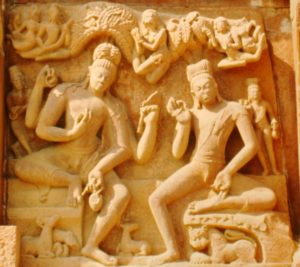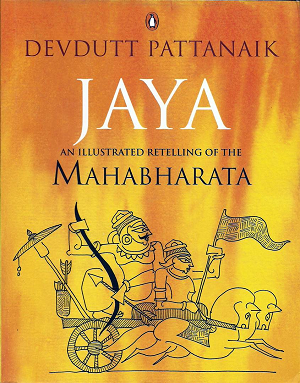Religions of South Asia 11.2-3 (2017) 345–347 ISSN (print) 1751-2689
https://doi.org/10.1558/rosa.37027 ISSN (online) 1751-2697
© Equinox Publishing Ltd 2018, Office 415, The Workstation, 15 Paternoster Row, Sheffield S1 2BX.
Review
The Mahabharata of Vyasa: Book XII The Complete Shanti Parva. Part 2: Moksha-Dharma. Translated from Sanskrit by Pradip Bhattacharya. Kolkata: Writers Workshop, 2015. 1112 pp., Rs. 2000. ISBN 978-9-350-45122-9.
Reviewed by: Satya Chaitanya, Mythologist, Corporate Trainer, Visiting Professor, XLRI School of Business and Human Resources, Jamshedpur, India, satyachaitanya@yahoo.com
Keywords: brilliant women; devotion; liberation; Mahabharata; meditation;
unconventional spirituality; yoga.
All human pursuits have for their end, said ancient India, either one or a combination of the four ultimate human goals: wealth (artha), pleasure (kāma), the common good (dharma) and spiritual awakening (mokṣa). The Mahabharata is an enquiry into these human goals in the context of the sad family saga of the Bharatas.
The epic has 18 parvans or books, of which the Śānti Parvan is the largest and has three subsections: the Rājadharmānuśāsana Parvan, the Āpaddharma Parvan and the Mokṣadharma Parvan. The biggest of these is the Mokṣadharma Parvan, bigger than the other two put together. It is this Parvan that Pradip Bhattacharya has brilliantly translated into English.
Mokṣadharma Parvan has devotion, yoga, meditation, dispassion, the ascetic way of life and other forms of spirituality for its subject matter. One of the most fascinating aspects of the Parvan is that, while it does speak
of conventional spirituality, much of its teachings are irreverent to tradition and it takes very unconventional stands. The very second chapter has a son teaching spirituality to his father. Later the brāhmana Jājali who has
become proud of the frightful asceticism he has performed for years is sent to the merchant Tulādhāra to learn from him, reversing traditional roles completely!
We have another story of role reversal in the Parvan in which a woman teaches the highest spirituality to a man—a story that introduces to us one of the most fascinating spiritual teachers in the entire Indian lore: the great
yogini Sulabhā. She arrives at the court of King Dharmadhvaja Janaka, reputed to be an awakened man, engages him in a debate and countering all his arguments, ends by declaring bluntly that he is no master but just a pretender.
You are not liberated
yet you are proud of being
liberated, O King! You should be prevented
by your well-wishers, as
the unconscious indeed is from drugs.
Sulabhā’s main argument is that Dharmadhvaja has not developed anāsakti—detachment while being fully engaged—the true mark of enlightenment. Sulabhā points out to Janaka that he is still attached to his body and identifies
with his gender, caste, position as king and so on.
We have several Gītās in the Mokṣadharma Parvan. In the short sparkling Bodhya Gītā, a great sage in another role reversal declares that his gurus are a prostitute, an arrow smith, a young girl and so on:
Pingalā, the osprey, the snake, the bee
Searching in the woods,
the arrow-maker and the virgin, these six
are my gurus.
Apart from the Bodhya Gītā, the Parvan has the Manki Gītā, Parāśara Gītā, Hamsa Gītā, Sampāka Gītā, Harita Gītā, Vr̥tra Gītā and so on, each enriching the Parvan in its own way. As the Upanishads do, the spirituality of the Parvan holds heaven in contempt equating it to hell in comparison to mokṣa. The Parvan rejects animal sacrifice. Though hermit spirituality too is discussed, the stress is on what can be practised while living the family life. In fact, one of the questions Yudhishthira asks Bhīṣma in the Parvan is if a man living with a wife at home can climb to the highest peaks of spirituality—a question that is very pertinent to all of us. In response, Bhīṣma tells him the fascinating story of Suvarcalā who chooses Svetaketu as her husband and lives with him a life leading both to the heights of spirituality. In this story we have a rare Brahmin svayamvara (a woman choosing her husband from a number of eligible suitors), usually limited to royal kṣatriya families.
The women of the Parvan are all brilliant, be it Suvarcalā who tells her father she would choose her husband by herself, Yogini Sulabhā who using yoga enters Janaka’s head to debate with him staying within himself, the wife
of Nāgarajā who teaches her anger-prone husband the importance of managing anger.
While Bhattacharya’s translation is basically in verse, he has translated the prose in the original into prose, which makes this the only verse-and-prose sloka-by-sloka translation of the Parvan. The translation is a monumental piece of work as well as a superb literary achievement. One of the unique aspects of the translation is the retention of Sanskrit words that are in the Oxford English Dictionary. An example for this could be found in the parvan-opening question itself which Yudhishthira begins with ‘O Pitāmaha-Grandfather’. A new reader finds this rather unsettling, but once you are used to it, you discover it has a charm of its own, giving the entire work a surreal quality. And of course, it avoids, as the translator points out, the need for annotations, colophons and
dovetailing explanations.
Bhattacharya’s mastery of the English language is astounding. With amazing fluidity, the mighty torrent of the translation flows on for 1077 pages, carrying us with it. Occasionally though the intentional literalness of the translation introduces a grating note into the otherwise beautiful harmony. For instance, I would have preferred the simple ‘all doubts cleared’ to the literal ‘all doubts severed’ (Section 320.25).
I also feel a Contents section at the beginning and chapter titles would have made the book more useful to researchers, though the translator does explain why he has omitted these. The Index appended does not meet with
this need.
Apart from these minor complaints, the Mokṣadharma Parvan is a superb example for what encyclopedic knowledge, hard work, superb literary talent and total commitment can achieve. The work is a masterpiece of Sanskrit translation. As a translator Bhattacharya eminently succeeds in achieving all the aims he sets for himself.

 How shall vibrant shoots of the future come forth unless we go to our roots? That is why Janamejaya, king of Hastinapura, requests Vyasa, his ancestor, to tell him about his lineage. Retellings of Indian mythology have been many but for the first time we have a medical doctor ministering to the spirit by evoking archetypal memories through his retellings. Of his work, the most significant is this attempt to re-tell the Mahabharata in a new way.
How shall vibrant shoots of the future come forth unless we go to our roots? That is why Janamejaya, king of Hastinapura, requests Vyasa, his ancestor, to tell him about his lineage. Retellings of Indian mythology have been many but for the first time we have a medical doctor ministering to the spirit by evoking archetypal memories through his retellings. Of his work, the most significant is this attempt to re-tell the Mahabharata in a new way. Meena Arora Nayak: Evil in the Mahabharata, Oxford University Press, 2018, pp. 355, Rs. 650/-
Meena Arora Nayak: Evil in the Mahabharata, Oxford University Press, 2018, pp. 355, Rs. 650/-